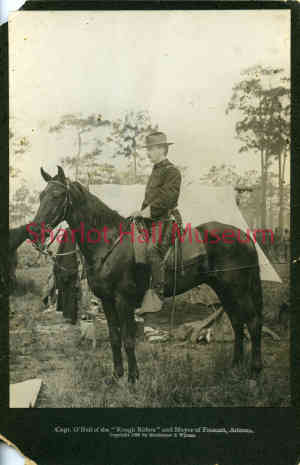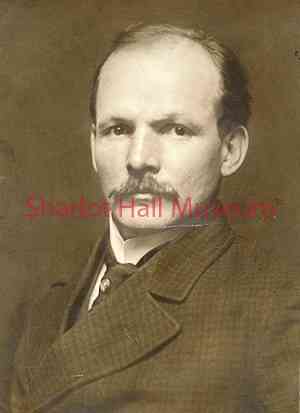by Drew Desmond
 After Governor Kibbey appointed the Rough Rider Memorial commission, designs for the monument were accepted. The first submitted was by architect M.J. Mahoney who used the Statue of Liberty as the base for the figure. Frank Leich, a sculptor from San Antonio, suggested a monument that was broad at the base and not too tall, “with a good portrait statue of O’Neill surmounting it, either in bronze or marble,” the Weekly Journal-Miner recorded. “You cannot make a number one equestrian statue out of it for the amount of money at the disposal of the committee,” Leich explained.
After Governor Kibbey appointed the Rough Rider Memorial commission, designs for the monument were accepted. The first submitted was by architect M.J. Mahoney who used the Statue of Liberty as the base for the figure. Frank Leich, a sculptor from San Antonio, suggested a monument that was broad at the base and not too tall, “with a good portrait statue of O’Neill surmounting it, either in bronze or marble,” the Weekly Journal-Miner recorded. “You cannot make a number one equestrian statue out of it for the amount of money at the disposal of the committee,” Leich explained.
Despite this, the governor’s commission, headed by Robert Morrison, headed to New York to see what could be done. When the Prescott contingent arrived in the east, their “enthusiasm began to sink when the price was more and more brought home to [them,]” the Weekly Journal-Miner related.
Sharlot Hall chronicled what happened next: ”However, without solicitation on his part, Solon Borglum came to see [Morrison]. He told him he knew of his mission, also what he knew of the regiment, and then continued, ‘Mr. Morrison, would you like me to do your monument?’ Mr. Morrison's reply was eminently characteristic: ‘Would we like it? Would we like to have dreams come true? There is nothing in the world we would like so much—but—Mr. Borglum, we haven't the money to offer you for the work.’ “The sculptor asked, ‘How much have you?’ And upon Mr. Morrison's replying, ‘We have $10,000,’ [Borglum] said without hesitation: ‘You shall have your monument!’ and that settled it.” Prescott’s prayers were answered!
 Solon was the younger brother of Gutzon Borglum, best known for creating Mt. Rushmore. In March, 1906, Solon arrived in Prescott to show the committee his model. The committee was delighted with it, and Solon returned to New York to add the details. Toward the end of the year, Solon sent a photo of the face to the committee to be sure it looked like Buckey, and the sculptor was instructed to proceed with the casting. Meanwhile, Morris Goldwater was working tirelessly on organizing a formal reunion of the Rough Riders to be held at the unveiling. Eventually, July 3, 1907, during the annual Frontier Days celebration, was chosen for the unveiling.
Solon was the younger brother of Gutzon Borglum, best known for creating Mt. Rushmore. In March, 1906, Solon arrived in Prescott to show the committee his model. The committee was delighted with it, and Solon returned to New York to add the details. Toward the end of the year, Solon sent a photo of the face to the committee to be sure it looked like Buckey, and the sculptor was instructed to proceed with the casting. Meanwhile, Morris Goldwater was working tirelessly on organizing a formal reunion of the Rough Riders to be held at the unveiling. Eventually, July 3, 1907, during the annual Frontier Days celebration, was chosen for the unveiling.
 At this point, private contributions amounted to only $1,221.95. That money was earmarked to obtain a base for the statue, and Solon took this matter as seriously as the statue itself. On his visit, Solon noticed the beauty of the rocky outcroppings surrounding town. He decided that one of the beautiful local granite boulders would be a perfect base, and he personally returned to the city to choose it himself. The boulder was harvested from Yavapai Hill, weighed 28 tons and was “about 9 feet in length, 4 feet in thickness and rising in height about 5 1/2 feet. It [was] placed on a stone foundation about 2 feet higher than the surrounding level of the plaza,” according to the Weekly Journal-Miner. It reportedly took “several weary days” for a 20-mule team to move it, mostly downhill, to the plaza. The statue itself was 10 1/2 feet in height, making the total height of the monument about 18 feet.
At this point, private contributions amounted to only $1,221.95. That money was earmarked to obtain a base for the statue, and Solon took this matter as seriously as the statue itself. On his visit, Solon noticed the beauty of the rocky outcroppings surrounding town. He decided that one of the beautiful local granite boulders would be a perfect base, and he personally returned to the city to choose it himself. The boulder was harvested from Yavapai Hill, weighed 28 tons and was “about 9 feet in length, 4 feet in thickness and rising in height about 5 1/2 feet. It [was] placed on a stone foundation about 2 feet higher than the surrounding level of the plaza,” according to the Weekly Journal-Miner. It reportedly took “several weary days” for a 20-mule team to move it, mostly downhill, to the plaza. The statue itself was 10 1/2 feet in height, making the total height of the monument about 18 feet.
Everything seemed in order for the gala reunion except for one last problem. Before leaving for Prescott himself, Solon carefully wrapped and shipped the statue from New York. He was dismayed to learn that he beat the statue to Prescott but was told it would arrive soon. Days passed and the bronze work was still missing. The situation became critical. “It was feared it would not [arrive] on time," the paper recalled.
To be concluded in the last installment next week.
“Days Past” is a collaborative project of the Sharlot Hall Museum and the Prescott Corral of Westerners International (www.prescottcorral.org). This and other Days Past articles are also available at www.archives.sharlothallmuseum.org/articles/days-past-articles/1 The public is encouraged to submit proposed articles and inquiries to dayspast@sharlothallmuseum.org Please contact SHM Research Center reference desk at 928-277-2003, or via email at archivesrequest@sharlothallmuseum.org for information or assistance with photo requests.


